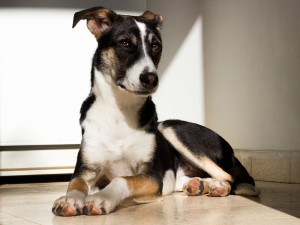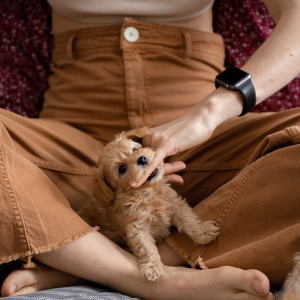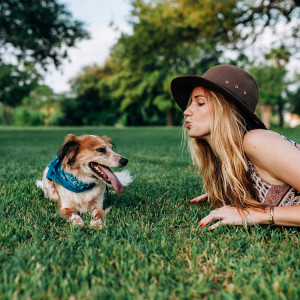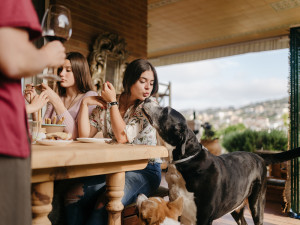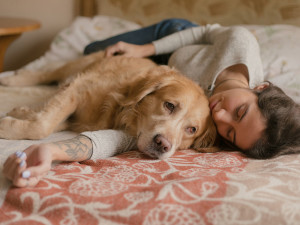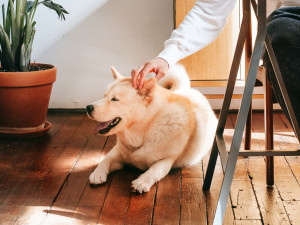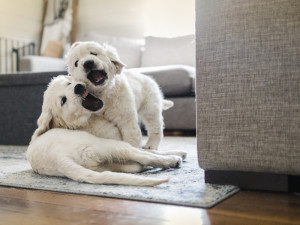Understanding Reactivity and Aggression in Dogs: Two Very Different Things
Turns out, even experts have a hard time defining these terms.
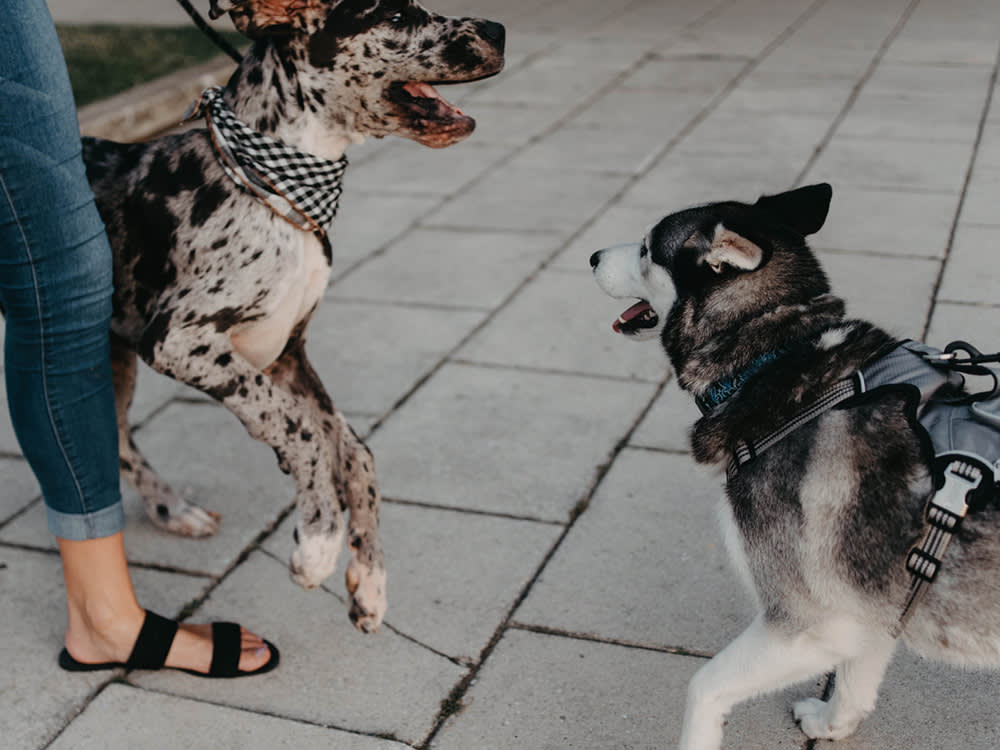
Share Article
In this Article:
What Is Reactivity? Examples of Reactivity in Dogs What Is Aggression? Examples of Aggression in Dogs
Historically, the term “aggression” was used broadly to encompass various troublesome behaviors which can be problematic, such as barking, growling, lunging, and snarling. Unfortunately, there is a lot of shame associated with having a dog who is labeled “aggressive.” It’s not as loaded a term as an “angry dog,” but it still makes many dog parents feel bad unnecessarily.
The introduction of the term “reactivity” aimed to address this issue by providing a more neutral, less judgy label for certain behaviors. The term “reactivity” came about in part to assuage people’s shame about having an aggressive dog which is why some of the first uses of the word involved discussing “leash reactivity” which is essentially the same behavior that has long been called “leash aggression.”
Reactivity refers to a response to a stimulus that is perceived as excessive or intense, while aggression traditionally involves behavior with the intent to harm. Many people consider the term “reactive” more appropriate for their dog, and are more comfortable using it. The fact is that dogs are either aggressive or reactive based on the descriptions above, but some dogs are accurately called both aggressive and reactive. Rather than focusing on labels, try to focus on addressing specific behaviors, because aggressive dog training and reactive dog training involve the same skills and require the same knowledge to be successful.

What is reactivity?
Reactivity is frequently used to mean a response to a stimulus or a trigger that is over the top — usually based on big emotions, as we say these days. Part of the challenge of using the term “reactive” is that it requires us to determine whether a dog’s response to something is excessive, and that depends on many variables: what caused the dog to react, what a normal response would look like, and so on.
The idea is that a reactive dog is one who is responding to a stimulus in any way that is beyond what the situation calls for. That can include dogs who are so happy to see people or dogs, or a specific person or a dog (or even a toy) that they respond with excessive enthusiasm. It can also include dogs who get extremely aroused because of a negative emotional response when they see people or dogs (or even other animals, or if they hear certain sounds) and appear incapable of exercising the proper amount of self-control.
Examples of reactivity
Reactivity is a subjective construction because it means a response to a situation or a trigger that is more intense than expected by a typical dog. So, a dog who barks when the doorbell rings but then stops and calmly greets the visitors would not generally be called reactive.
But a dog who barks in response to the doorbell and slams their body into the door over and over while spinning, leaping, barking ever louder, and being inconsolable would reasonably be called reactive. These cases are not going to prompt much argument, but what about all the variation that’s in between these two extremes? It’s not easy to determine the line between behavior that indicates reactivity and typical canine behavior involving some level of excitement. Basically, the answer to “What is a reactive dog?” depends on who you ask.
What is aggression?
Aggression is historically used to indicate something about intention, because a common definition of aggression is behavior with the intent to harm another individual. There are people who vehemently disagree with the inclusion of intent as a part of the definition of aggression because it is not possible to know for certain what a dog’s intention is. They prefer to look only at the behavior without ascribing any intent to the dog exhibiting the behavior. It’s a fair argument that it’s more useful to describe what a dog does than to label them an aggressive dog.
So, sometimes the definition is “any behavior that causes harm to another individual or threatens to.” An issue with this definition is that a situation that causes harm could also just happen from an accident a dog has, such as falling off a surface, like the couch, and scratching someone on the way down unintentionally or knocking someone over when greeting them exuberantly. Ugh — definitions are so hard!
Agonistic behavior
Aggression is just one of many types of behavior that fall under the category of “agonistic behavior,” which is any social behavior that r elates to fights or contests. The other ones are threats, displays, placating, and reconciliation. Threats, displays, and placating behavior can reduce tension and lower the likelihood of aggression.
Over time, threats and displays have been lumped in with aggressive behavior by dogs, which means that some behaviors that may actually prevent harm to one dog (or a person) by another dog have been included in the category of aggression. That leads to a weird situation in which many of the behaviors we describe as aggressive in dogs are actually agonistic behaviors that have the intent to reduce conflict and to avoid fighting.
The truth: Defining dog behavior is complicated.
Trying to define all behavior precisely and accurately is inherently problematic because we are trying to overlay a simplistic form of clarity over the truly complicated nature of behavior. Definitions seek to make things simple and easy to understand, but that is really difficult because of how complicated behavior is, especially when conflict and arousal are involved.
Reactivity alludes to the emotional aspects of what is going on, and “aggression” more commonly refers to intent and to the possibility of injury. Many people find it frustrating that reactivity is so often confused with aggression, but that’s not surprising, given that the terms are not mutually exclusive. If you try to sort all dogs with certain types of undesirable behavior into those who are aggressive and those who are reactive, it’s impossible because you are trying to fit three categories of dogs into just two categories.
Some dogs, based on a general understanding of the terms, are both reactive and aggressive. Their emotions are over the top, and they may hurt someone. Others are just reactive. They are highly aroused and respond to other individuals in an intense way, but they never hurt them or try to hurt them. And some dogs are just aggressive, but not reactive. I’ve met dogs in this last category, though I think it is the rarest of the three groups. Those particular dogs may bite, and even cause a high level of damage, but they do so without any of the emotional arousal so typical of most scenarios. (Usually, a dog who bites is either fearful — this is the most common emotional state of dogs who bite — or frustrated or in a high state of arousal.) Dogs who seem emotionless when they bite and exhibit no emotion after the bite remind me of movie depictions of hit men. I picture them saying, in their dog language, “This is not personal. It’s just business,” before they seriously injure someone with a bite.
I tend to recognize the term aggression the way that most people who book appointments with me use the term — to indicate any behavior that gives them a bad feeling that someone could get hurt by the teeth of their dog. That refers to all the barking, growling, lunging, cold stares, tooth displays, nips, air snaps, and bites.
What about body language associated with aggression and reactivity?
You can’t reliably distinguish aggression and reactivity based on body language alone. Both aggressive and reactive dogs can bark, lunge, growl, run, tuck their tales, leap around, cower, exhibit piloerection, pin their ears, show their teeth, or give a fear grimace, among other behaviors.
Aggression has to do with intent and injury, but also relates to conflict resolution, and reactivity has to do with excessive arousal, but reactivity and aggression are not mutually exclusive. Arousal is one cause of aggression and a dog who is reacting excessively fearfully can behave in an aggressive manner because of their fearfulness.
Focus more on the behavior, less on the label.
I know it’s a wild dream that will never come true, but it would be my preference to focus on the behavior and avoid labeling it. Labels have value for brevity and ease of communication, but so much is lost when we group large numbers of dogs into a small number of categories because of a desire to define behavior. Additionally, without any clear consensus on what these terms mean, clarification is always needed when we communicate with one another, and when someone uses either of these terms. Rather than say a dog is aggressive or a dog is reactive, I like to say, “This dog barks and lunges at unfamiliar people who she sees while on leash” or “This dog bites people who reach for him.”
An emphasis on describing the behavior rather than defining it avoids the confusion that can arise when the terms “aggressive” and “reactive” mean different things to different people.
FAQs (People also ask):
How can you train reactive or aggressive dogs?
All dogs, including those who are reactive and aggressive (or both), should be trained with positive reinforcement and patience. Set dogs up for success, have reasonable goals, and use management to keep everyone safe and relaxed.
When should I involve a professional for reactive or aggressive behavior?
The knowledge and skills of professional behaviorists and trainers are assets when working to improve the behavior of any dog, but are essential for appropriate safety measures and good progress with aggressive and reactive dogs.
What should I do if my dog keeps biting me aggressively?
Seek professional help from a qualified canine behaviorist or dog trainer, and consult with your veterinarian to rule out medical causes if you have had the very distressing experience of your dog biting you.
References:

Karen B. London, PhD, CAAB, CPDT-KA
Karen B. London is a certified applied animal behaviorist (CAAB) and certified professional dog trainer (CPDT) who specializes in working with dogs with serious behavioral issues, including aggression. She has written for a variety of magazines including The Bark, Clean Run, and the APDT Chronicle of the Dog, and has published in scientific journals including Behavioral Ecology and Sociobiology, Ethology, Ecology, and Evolution, the Journal of Insect Behavior, and Insectes Sociaux. She is the author of seven books about dog training and canine behavior, including the forthcoming My Dog's Mystery Adventure: And Other Stories From a Canine Behaviorist and Dog Trainer.
Related articles
Does Your Dog Need Anti-Anxiety Meds?
How to cope with dog anxiety—from training to medication.
![Sad boxer rests on owners lap, dog doesn't want to be touched]()
How to Tell if Your Dog Is in Pain
And what to do to help them.
![Stylish woman sitting on a bench with her Boston Terrier dog.]()
Here’s Why Your Dog Is Terrified of New People
And how to change this.
![Unrecognizable man sitting at desk petting his dog]()
How to Pet a Dog — Yes, You Do Need Lessons
There’s a difference between being affectionate and being annoying.
![2 dogs playing]()
Does Your Dog Have Littermate Syndrome?
If you adopted puppy siblings — and they fight nonstop — you could be dealing with littermate syndrome. Here’s everything you need to know.
![Three dogs biting a stick.]()
Some Like It Rough: Playing Vs. Fighting
Two animal behavior experts agree it’s usually play fighting. Here’s how you can tell.
